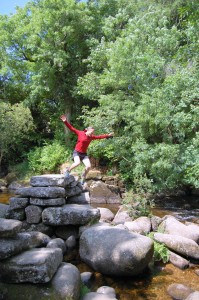Guest Blog: Where land meets sea, a perfect place to play
Where land meets sea, a perfect place to play By Rob Joules, National Trust General Manager…
We’ve been asked on several occasions how a running guidebook differs from a walking one. And surely you can just run anywhere, so why do you need a guide?
 We’ve travelled the country, and several others, getting out for a run each day as training and also as a means of exploring an area. Much as it’s fun to disappear into the unknown for a new adventure, it can be frustrating when you get to a new place and have to spend the first few days working out where the best runs are by trial and error. On numerous occasions I’ve ended up edging down a narrow verge on an A road or faced with an angry collie in someone’s back garden when I’ve been out exploring. So the aim of a running guidebook should be to inform and inspire; to give you some ideas for each area, highlight where the waymarked trails are and also to describe the type of running you’re likely to find. Walking guidebooks are a great start, and many walks make for fantastic runs too. Indeed we’ve included some of the great classic walks because they lend themselves so well to running. One of the huge differences, though, is that, although the places one visits might be breathtakingly beautiful, the act of walking is rarely an exhilarating experience in its own right. Running at speed through varying landscapes, across vast grassy plains or down steep scree slopes are experiences many runners want to include on their runs. Long, steep ascents become mini challenges within the context of a longer run. Puddles exist to be jumped over or splashed through. Records for a particular route can be beaten. The athleticism of running brings with it a whole host of possibilities and challenges that should be encompassed in a good running guidebook. And that’s why we think you need one 🙂
We’ve travelled the country, and several others, getting out for a run each day as training and also as a means of exploring an area. Much as it’s fun to disappear into the unknown for a new adventure, it can be frustrating when you get to a new place and have to spend the first few days working out where the best runs are by trial and error. On numerous occasions I’ve ended up edging down a narrow verge on an A road or faced with an angry collie in someone’s back garden when I’ve been out exploring. So the aim of a running guidebook should be to inform and inspire; to give you some ideas for each area, highlight where the waymarked trails are and also to describe the type of running you’re likely to find. Walking guidebooks are a great start, and many walks make for fantastic runs too. Indeed we’ve included some of the great classic walks because they lend themselves so well to running. One of the huge differences, though, is that, although the places one visits might be breathtakingly beautiful, the act of walking is rarely an exhilarating experience in its own right. Running at speed through varying landscapes, across vast grassy plains or down steep scree slopes are experiences many runners want to include on their runs. Long, steep ascents become mini challenges within the context of a longer run. Puddles exist to be jumped over or splashed through. Records for a particular route can be beaten. The athleticism of running brings with it a whole host of possibilities and challenges that should be encompassed in a good running guidebook. And that’s why we think you need one 🙂